Richard Hyde
I know about the horses, 2021
Postcards, suitcases, clothing.
Spoken language is intimately tied to the slice of time within which it was uttered and words thrown at us at that moment can pierce a fragile heart. But over time our assiduous brain can purposely shatter these harmful connections, separate the language from its interpretation, and create a new dawn of more positive narrative.
We see a set of personal memories, laid bare and with a new visual language attached to them. We are taken on a journey of reinterpretation that is aligned to Judith Butler’s assessment that “Words might, through time, become disjointed from their power to injure and be recontextualized in more affirmative modes.”
In this installation, the artist encourages us to reassess injurious language from our own past and reframe it in a reimagined, more positive landscape.
Final outcome
We see a set of three open antique leather suitcases on the floor spewing out their contents of torn clothing and postcards. Each case has a collection of different coloured cloth (red, white or green) and a different photograph on each of the scattered postcards. The suitcases sit close together and have burst open with their lids ajar in a similar fashion.
The ten or so postcards in and around each case sit pristinely on top of the contrasting torn clothing and they are blank, they have never been sent, as we see the reverse with no writing on them. There is a connection between the colour of the clothing in each of the suitcases and the colour of the dress the woman is wearing in each of the postcard images.
The three different sets of postcards each show a smartly dressed woman in a remote location, head concealed by an animal mask and confidently presenting a placard on a wooden stick towards us. The placards show a short message in German, presented in a retro bitmap font. The pose of the woman is full-frame, dominant, even aggressive, across all three images.
Starting point
A set of letters from a past relationship formed the starting point for this project. These were written over a number of years and contained extremes of emotive language as a separation took place.
Research strategy
The interplay between the analogue and digital worlds and how artists transcode their work between the two initially sparked my interest. This involved research into digital tools including programming environments, open-source music creation tools and modern technologies such as augmented reality, hieroglyphic and sentiment analysis generation tools. The research was extended to a study of generative art techniques which touched on artificial intelligence (AI) as well. A number of open-source tools were downloaded and experimented with as part of this exercise.
Research on techniques of layering analogue and digital media then took place which involved a study of relevant artists, media and processes that could be used to create potential outcomes.
The most detailed research element was on the philosophy of language, which involved an intense historical study of philosophers, thinkers and art historians to help guide my own integration of language and maximise the potency of the outcome.
When it came to considering the final installation, a final research study on artists who create immersive installations was useful in finding the most appropriate scale, layout and props for my own work.
Concept
A fascination with language uttered in the past formed the concept for this project and how an artistic interpretation could portray how that language moved its goalposts as time passed. This extended to investigating human strategies for recontextualising injurious language as part of a subconscious recovery.
Materials
A wide variety of digital tools were initially used that included computer programming and augmented reality apps. This moved on to analogue materials such as paper and canvas but the focus was then on photography with props and installation using found objects.
Health and safety
There were no major health and safety concerns throughout the course of this project other than travel to remote locations for photoshoots which took place in winter and my model was extremely cold at points. Consequently, photography took place at speed in some cases which was not ideal but it was a small price to pay for the images that were obtained.
Artist inspiration
Wassily Kandinsky and Robert Dunt were looked at to understand how they have taken source information and changed it from one form of coded representation to another, specifically how music was their inspiration for abstract paintings.
The digital artists Harold Cohen, Andy Warhol and John Conway (Game of Life) were studied during my investigation of digital art and this led to a study of the work of Manfred Mohr as the father of digital art.
My interest in contemporary art with a digital aesthetic led to me looking at the varied work of Timur Zagirov and Baltazar Pérez to understand how they had left a trace of the digital.
As I moved on to investigate the interruption of history the likes of Nigel Grimmer, Catherine Panebianco and Richard Dawson were found to create a wonderfully varied palette of work from which inspiration was gained.
Further artists who leave only a trace of the digital, such as Nick Smith and Ana Martins consolidated my move towards a more analogue outcome.
My deep study of the philosophy of language required a study of René Magritte, Immanuel Kant and Roland Barthes to get to grips with how language was transmitted, received and recoded by the human brain.
More thinkers and philosophers of language were studied such as Paul-Michel Foucault and Slavoj Zizek but it was Judith Butler who gave me the clearest direction to my own inclusion of language in my work.
As I got close to an installation-based outcome I was inspired by the work of Marcel Duchamp, Mohamad Hafez and Joachim Schmid who all used baggage in different ways to indicate many different aspects of human existence.
Christian Boltanski was my final choice of inspiration as his immersive installations were a close parallel to my own work. His suitcases, clothing and sense of loss have inspired me in a previous project and now he led me confidently towards my own final result.
Experimental development
The first experiment was a purely digital analysis of the set of letters using an online sentiment analysis tool. The resulting graph below was a fascinating insight into the emotive content of the letters in how it underwent a period of rapid transition at the midpoint. This opened up the potential of converting the analogue letters into a digital form, particularly in how digitisation can condense large data sets into simple visuals and offer new insights. In essence, this experiment immediately confirmed that the source content had real potential for an artistic outcome.
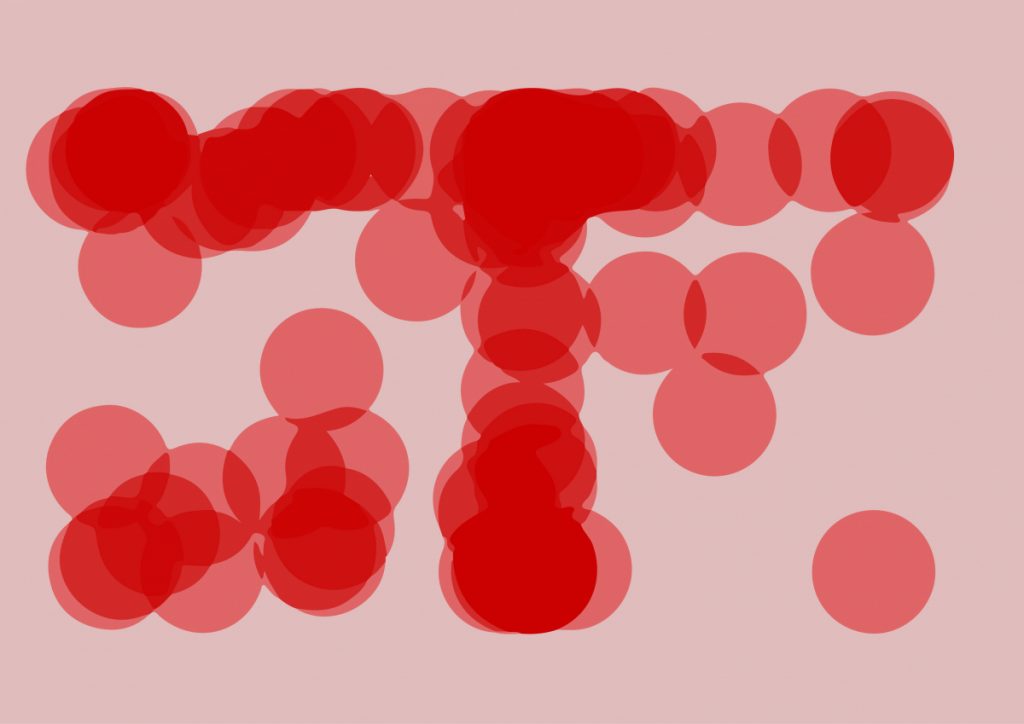
Below we looked at alternative visualisations of the graphed sentiments. The recreation of the graph using historical photographs creates emotional chaos and a human narrative giving a hint of the source of the data. This was worthwhile but I felt that the language of the letters had been lost and no replacement had been made, so no new insights had been revealed.
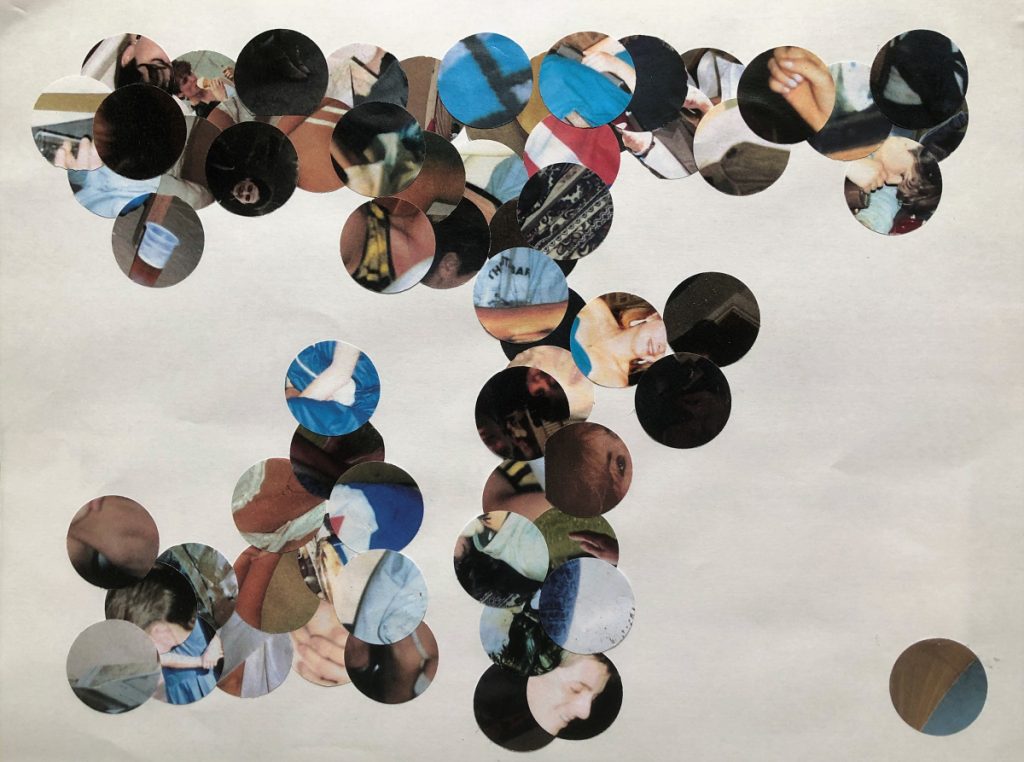
A hieroglyphics translator was also fed with the words from the letters and created the wonderful wallpaper strips below. This was nicely abstracting the original source to reveal new patterns, which were more successful than above. The historical narrative of stone carving had a vitality and permanence that I enjoyed. But as before, the original language had not been replaced with anything of more artistic significance.
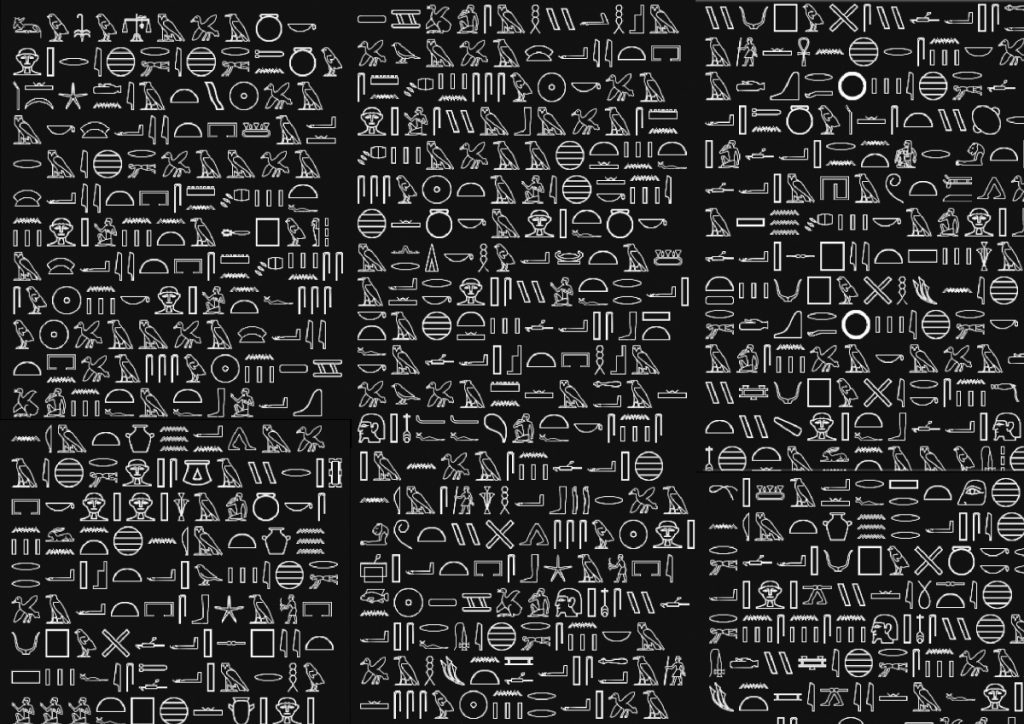
Following a study of artists who transcode and a detailed study of digital art, I experimented with recreating the classic game of life in an analogue form and layering this over the written word. The stitching had a homeliness which was a stark contrast to the writing so that created tension but I felt that the animation was a distracting novelty. We are intrigued by a clever algorithm rather than on the real object of power – the original words.
I then studied the work of artists who interrupt history by overlaying frames and photographs which was a real insight into the importance of conveying a sense of history into the work. Then a series of experiments looked at how music might interrupt the written language. Vivaldi’s Four Seasons and the original letters were burnt on canvas as an abstract form of destruction. For the first time, I purposefully let go to let my ideas flow free of my often too analytical self. It was an exciting process and the result below was entirely unplanned but satisfying.
Multi layering was working as it was adding layers of time, reinterpretations of the original letters and new emotional states. Music and fire added emotional poetry but I still felt there was more interplay to be had with the words themselves.

I studied a selection of artists who create analogue work with a digital aesthetic and then revisited the hieroglyphic idea but in the form of the tattoo below. Once again this was a very exploratory moment with direct personal involvement as we can see. This is a strong image of Christ sacrificing himself for religion and for others but I felt that it had gone too far off the tangent of language.
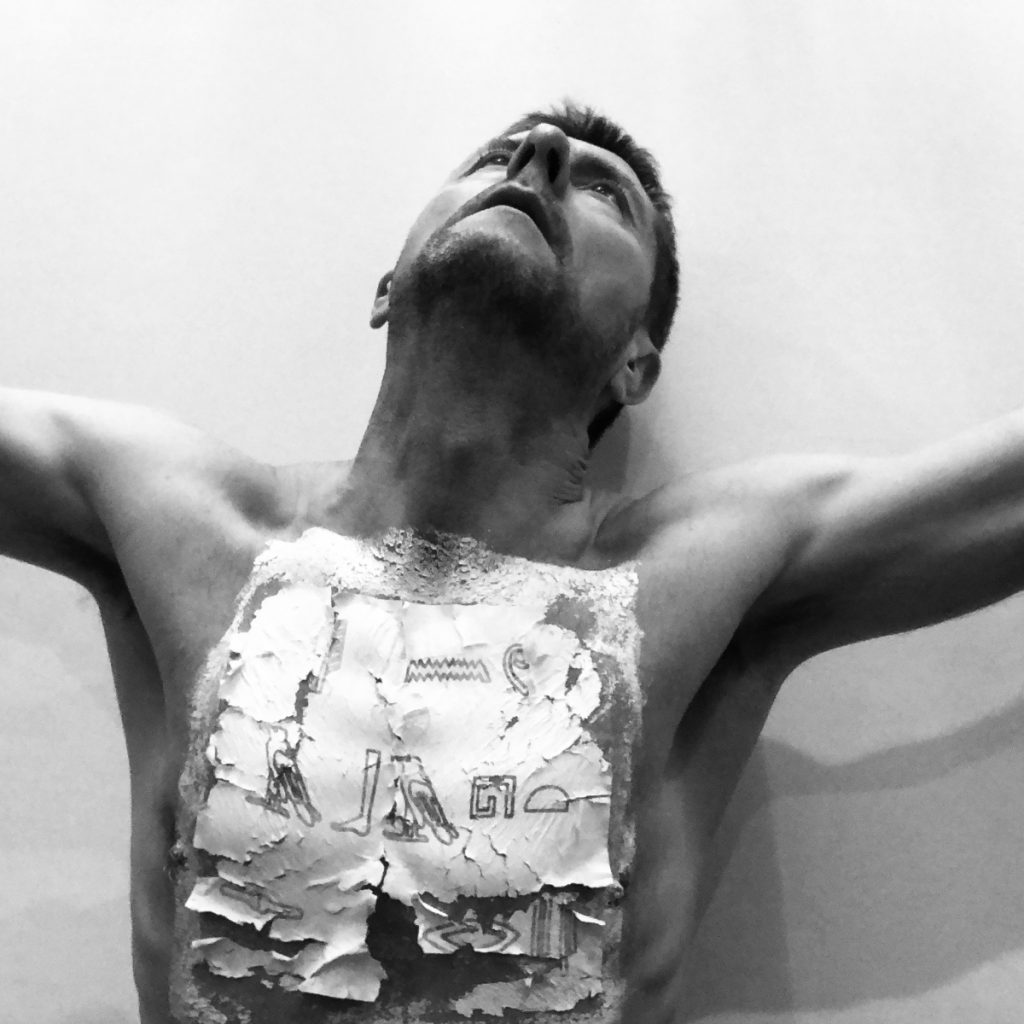
To help refocus, I undertook a detailed study of the philosophy of language through Kant and Barthes which drew me back to a fascination in language. The free play described by Kant was intriguing as the ultimate sweet spot of visual power to give to one who experiences art. The quick experiment below attempted to chop up language and offer a new form of assemblage. While not being fully resolved, this did convince me that if I found the right combination of language and props I could make a quantum leap with the project.
The research I’d undertaken on language had refocussed me back on the power of language and how small uttered phrases can have such a profound effect on the self. I now took some of the most memorable phrases and planned to create a series of staged reenactments. My thinking was that pulling out the most emotive language would have more impact than trying to represent the whole content, which would likely be more mundane.
The first photoshoot below moved the project into new territory. A perfectly mysterious morning, props and a willing yet angry model created a series of very satisfying images. The single translated phrase (“I know about the horses”) presented in a surreal context was powerful and I really enjoyed the satirical treatment of the original words. The retro aesthetic was like a voice from the past clinging onto something that has long since passed. Peer review at this point confirmed the success of this stage of the project.

The layering of analogue and digital content was a theme at the start of this project so at this stage I investigated augmented reality as a way to add a digital layer on top of the previous photoshoot. This is an impressive piece of technology that often astounds people and the added humour of a mass of running horses was entertaining. My concern though was that technology was overriding the deeper intended meaning and we were using a gimmick to draw in viewers and distract them from adding their own narrative. So I disregarded augmented reality as an option.
After the success of the first photoshoot, I now planned a second one. I was careful to create a similar layout to enable the series of images to work together, should that be the outcome. This time the phrase was “One day I’d like us to go for a walk” hence suitable props were gathered. This image from the shoot was a perfect complement to the first image in composition and most significantly it had a satirical treatment. At this stage, I was very confident about where the project was going so I continued to search for further locations and props.

A further study of more philosophers of language now took place and this included looking at Foucault, Zizek and Judith Butler. The words of Butler below really struck me as being the essence of what I had been working with. The photographs I’d constructed so far show me taking ownership of the injurious language and recontextualising it as a form of healing therapy. Philosophy and work were really starting to mirror one another.
“Words might, through time, become disjoined from their power to injure and be recontextualized in more affirmative modes.”
– JUDITH BUTLER
A third photoshoot took place at an even more remote location. This time the phrase was “We need to talk”, hence the props and dress to match. Another strong image that sat well with the others. I had a series of three strong images that were working well together but this was by no means an outcome. Photographs on their own give no context other than what we see in the frame and there was a much richer story to tell with the right presentation. It was time to investigate further layering of the images, the addition of props and options for the physical printing of the photographs.
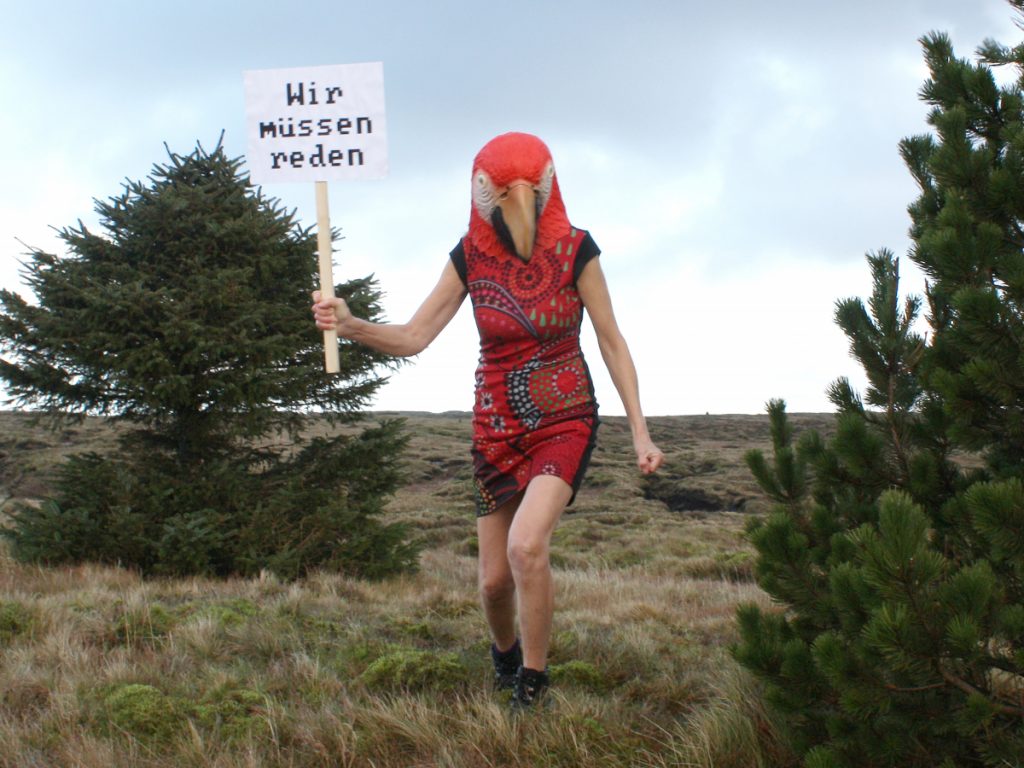
Inspired by the work of Catherine Panebianco who overlays family photographs at their original location I carried out the experiment below. A Polaroid of the photograph held at the location it was taken at creates an immediate historical narrative. We see something that is fondly reminiscent of the past but brings the past back into the present day. My summary was this was still limiting the photographs to 2D whereas they had so much potential if they were allowed to explode into a 3D space. Secondly, fond reminiscence was not an emotion I felt towards the subject of the work, remembering the words of Butler I needed to focus on the new context the words had gained in my head.
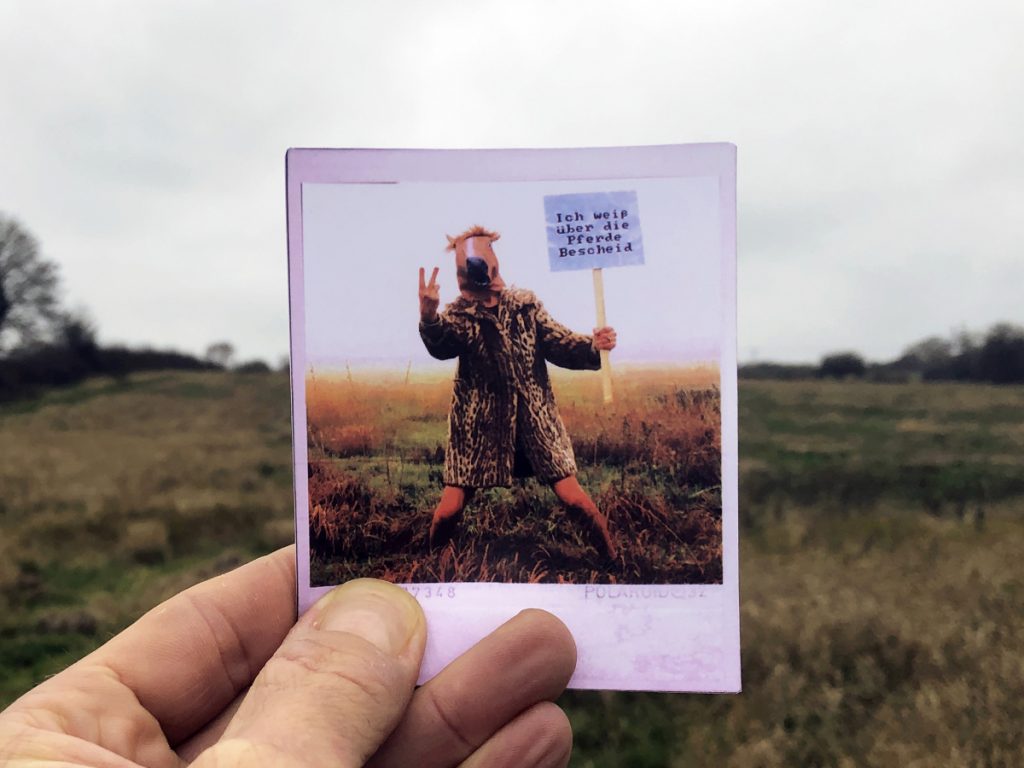
Suspending the photographs in space, in front of a backdrop was a potential gallery option that I now considered. An A1 sheet was stuck together and an image was painted on in a bitmap format. Before I’d even finished this experiment I realised that it did no justice to the photography – the narrative was weak and the retro construction of the painting added little. There was much more play to be had with bringing the outcome into 3D so this option was discarded.
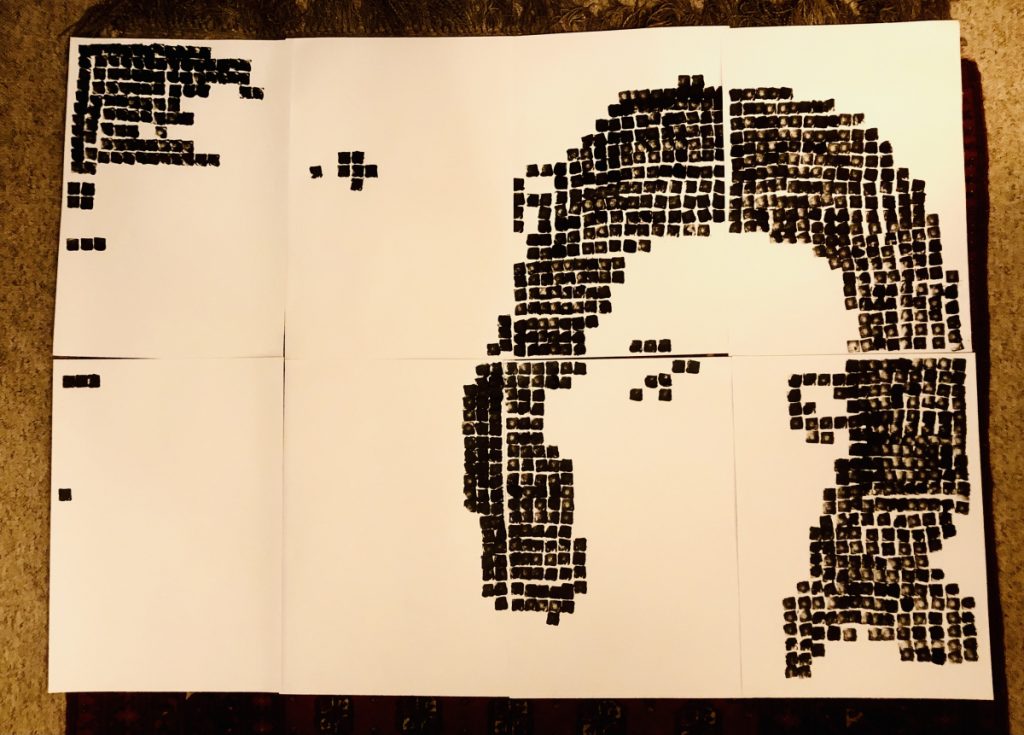
Then came the idea of using suitcases. The suitcase has a richness of meaning that I’d gathered from the earlier study of artists that use them, such as Christian Boltanski. With three cases available I put together the dresses worn in each of the photographs with a scatter of postcard-sized prints of the images. The multiples of cards had an immediate appeal and the link to the dress colour had an intent that I thought had good potential. The neatness of the folded dresses was a question I pondered on as that arrangement had a significant impact on the meaning of the whole piece. The arrangement below looks calm and ordered which didn’t really reflect the disorder in the language so I decided to look at other options for the clothing.

Before the next experiment, I looked again at the work of artists who show their baggage, such as Marcel Duchamp and Christian Boltanski. This convinced me of the relevance of the case as a vehicle for the photographs.
The neatness of the clothing I used previously was changed to a more random scattering of torn cloth. To validate the use of postcards, below I ripped up a larger version of the photograph to see how that integrated with the piece. My conclusion was that as well as the photograph completely losing its impact, the torn image is lost amongst the torn clothing. Hence I discounted a shredding of the images and focussed back on pristine postcards.
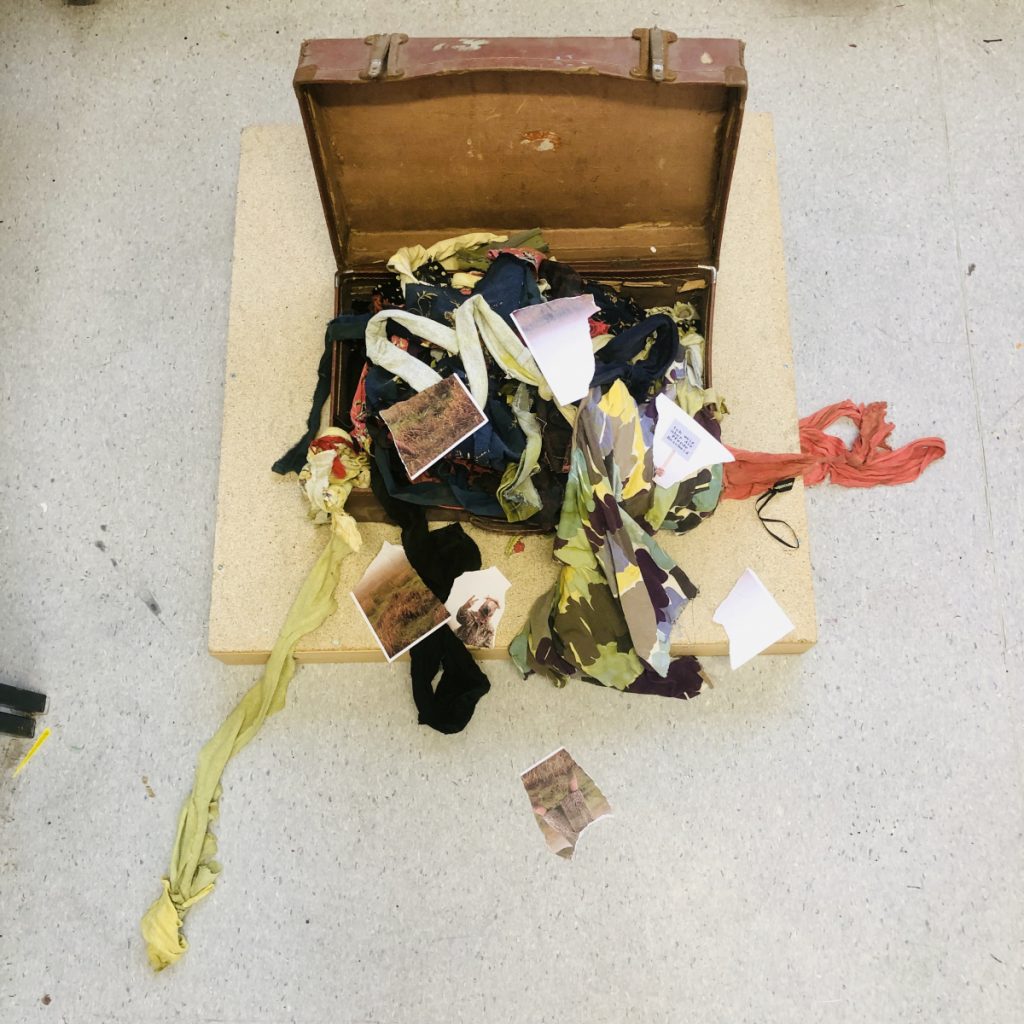
Back in the studio I located three antique cases, three sets of coloured and torn clothing and had postcards professionally printed, with a photograph on one side and blank postcard graphics on the reverse. The postcards looked superb and the contrast against the antique chaos of the cases created what I thought was a satisfying visible tension.
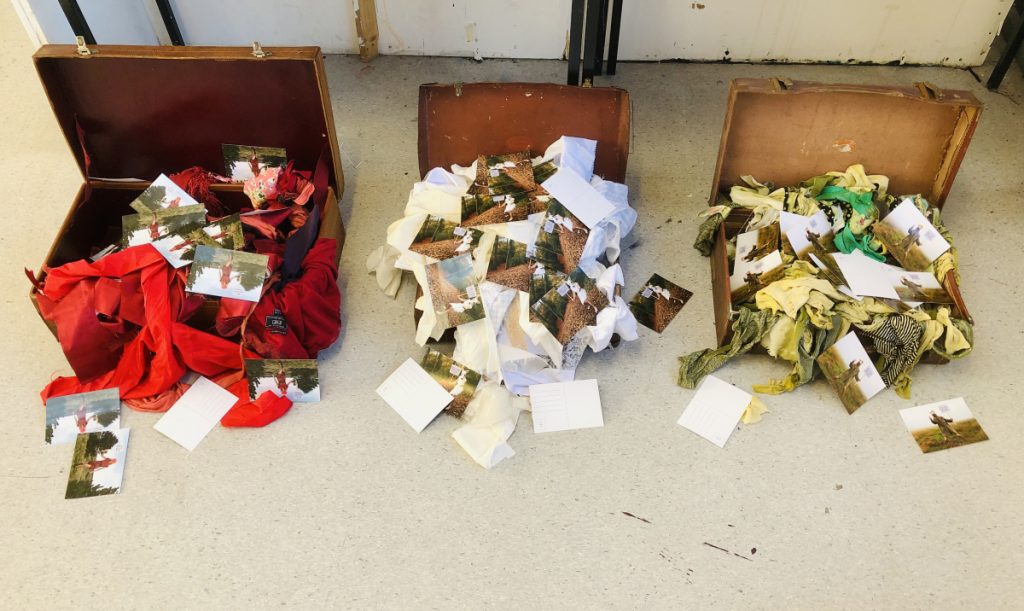
This was to be my final piece but at this stage, the studio was closed due to the pandemic lockdown. My intention was to mount each of the cases on a separate white plinth and to light each with a single spotlight in a white space. I wanted to create rich shadows and colours and illuminate the postcards well enough to see the imagery and read the text. The nature of the lighting and the presentation of an artwork impact it significantly, so will be considered carefully as and when we are able to return to the studio and hopefully mount the final exhibition.
Evaluation
This outcome has condensed a substantial quantity of analogue source material into a set of three suitcases, torn clothing and blank postcards. Each experiment has been carefully considered and has driven me towards what we see above. I considered at the start whether to represent everything in the letters but I remain convinced that this would have diluted the potency of key phrases. In taking almost everything away I have caused the remainder to deliver an energetic verbal punch using only the most loaded language as a vehicle.
The suitcases show us a journey, a state of transience or even a collection of memories. The outcome works on all these levels as we are certainly looking at a historical period that was a state of great upheaval for those involved and there are memories attached to that time which we are being granted a voyeuristic peek at.
The contents of suitcases are intimately private and we can tell a great deal about someone from what they carry with them. I suggest that the suitcase is one of the most notable ways to define a person (an equal to what they put in their supermarket trolley). These are both collections we often make subconsciously, never expecting anyone to tease them apart and interrogate our inner psyche. Does this not mirror some language, the type that is uttered in a heightened emotional state and only later do we say to ourselves “Why the hell did I say that?”. The language we see above is certainly bursting out of what should be a calm and personal space.
The three cases form a visually appealing triptych and there is natural poetry in how the material colour draws the viewer in to connect with the clothing the model is wearing in each of the postcards. We find ourselves questioning whether we are seeing the actual dress, torn violently to shreds but as we study closer we realise that there is more complexity here than meets the eye. The torn clothing houses the disconnected words and it provides a substrate into which the language has been stirred. We infer from this that the healing that has occurred here has involved both a physical and a mental struggle.
The photo series I created is a great success as they are well themed in composition, style, message and landscape. The images scream out at us with a satirical voice – what was once the most hurtful language is now strange and unfathomable by a viewer. I enjoy that disconnect from the separation and how a new audience might attach the language to an entirely different circumstance. It’s fascinating how the same language uttered in different circumstances is likely to have a wildly different impact – once again I’m reminded of Judith Butler’s assessment that language becomes disjointed as time passes. The cliche of time being a healer is because of this slow detachment I guess.
The faceless model shows us that the words have been isolated from their original owner and are now ownerless, drifting in a surreal landscape trying to attach to something new. Our only clue to the personality is the animal head and dress colour. We see red as anger, white as innocence and green as envy, which neatly matches the three phrases.
Blank postcards show us a communication that was never reciprocated or stock of intended communication that never materialised. Do we puzzle as to what could be written on the cards to explain what they show us? I enjoy the experience as a viewer as to what I would write on the cards. It certainly wouldn’t be “Wish you were here”, rather “Glad you’re not here”. This interruption in intent is curious – the physicality of the material sits tensely with the shop perfect cards which I think creates an intense curiosity.
This project has involved a deeply personal journey, in fact, it has required me to open up a past that has been previously uncomfortable to verbalise. But the process has been both therapeutic and necessary and I postulate that only art could have achieved this. My hope is that this study of language will allow others to deal with their own past and realise that words lose their injurious nature over time.
Future potential
This project has dipped its toe in the digital and analogue worlds and opened doors to many unexplored avenues along the way. Many of these opportunities were beyond the time and resource constraints of the project but I explore some of the more interesting ones below:
- Returned postcards – for this outcome I chose to use blank postcards but it crossed my mind to issue cards to the public for them to return to me. With no explanation, I could ask them to write a response and send them back to me and these written cards would then accompany the piece. Multiples of the same postcard all being sent to me would add a very different dynamic: a bombarding by third parties adding their take on what they saw, and these multiple interpretations would open up the viewer experience to be inclusive and allow them to add their own voice. Alternatively, blank cards could be available in the exhibition space for visitors to complete and the most relevant could be added to the exhibit. This interaction would probably be more polarised and lead to more revealing responses.
- Music from words – my foray into the potential of using music and graphic generation tools was paused due to time constraints and a concern that much effort would lead to a dead-end in terms of potential. Open-source music generation tools exist that, given adequate time, could be used to create music or tones from language. An algorithm could be written to convert words or sentences to musical notes based on a suitable transcoding system. To sit and listen to a symphony of musical tones, accompanied by photographs or words would be a heightened emotional experience and the engaging aspect of music would quite probably entice the viewer to linger and contemplate the impact of language on themselves.
- Colour from sentiments – the sentiment analysis tool I used at the start of the project was fascinating in how it visualised the emotive quality of writing. A further programming exercise would be to capture language in real-time and visualise it in colour using a sentiment analysis tool. What an interesting way for people to understand the nature of their own language. Two booths side by side with microphones would allow a couple to have a conversation and the colour of their respective language could be shown in real-time. Marriage guidance in an artistic form, I could call it Coloured Counselling.
- Site-specific piece – during the project I looked several times at taking the project back to the location where the words were uttered, or one where extra satire would be possible. A photoshoot in a horse’s stable was one idea for the “I know about the horses” concept, using equine artefacts to their best effect, for example, a neon sign with the words on it, a horse branded with the words or a pile of horse dung with postcards on it. There would be much fun to be had with that single idea as the horse phrase is the one that has lingered longest in my mind. Scale is something that I’ve been limited with on this project due to the lockdown situation but a large site-specific intervention along these lines would be an exciting opportunity to take the concept of recontextualised language to the field but most importantly to the people.